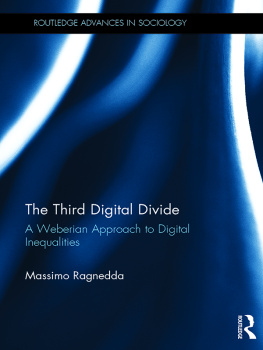S OCIAL I NEQUALITY AND S OCIAL S TRATIFICATION IN US S OCIETY
Social Inequality and Social Stratification in US Society uses a historical and conceptual framework to explain social stratification and social inequality. The historical scope gives context to each issue discussed and allows the reader to understand how each topic has evolved over the course of American history. The author uses qualitative data to help explain socioeconomic issues and connect related topics. Each chapter examines major concepts, so readers can see how an individuals success in stratified settings often relies heavily on their access to valued resourcestypes of capital which involve finances, schooling, social networking, and cultural competence. Analyzing the impact of capital types throughout the text helps map out the prospects for individuals, families, and also classes to maintain or alter their position in social-stratification systems.
Christopher B. Doob is Professor Emeritus of Sociology at Southern Connecticut State University. His published works include Sociology: An Introduction, 6th Edition (Harcourt Press 1999); Social Inequality and Social Stratification in US Society (Routledge 2012); Race, Ethnicity, and the Urban American Mainstream (Pearson 2004); Racism: An American Cauldron, 3rd Edition (Pearson 1998), the second edition of which received a Myers Center Award for the Study of Human Rights; and Great Expectations: The Sociology of Survival and Success in Team Sports (Routledge 2018).
In addition, he has been active in his community, serving as coordinator for the Southern Connecticut State Universitys Urban Initiatives, which established math tutoring classes for inner-city children. He has also participated in the struggle for welfare rights and been a long-time volunteer in two local adult-education programs.
Second edition published 2019
by Routledge
52 Vanderbilt Avenue, New York, NY 10017
and by Routledge
2 Park Square, Milton Park, Abingdon, Oxon, OX14 4RN
Routledge is an imprint of the Taylor & Francis Group, an informa business
2019 Taylor & Francis
The right of Christopher B. Doob to be identified as author of this work has been asserted by him in accordance with sections 77 and 78 of the Copyright, Designs and Patents Act 1988.
All rights reserved. No part of this book may be reprinted or reproduced or utilized in any form or by any electronic, mechanical, or other means, now known or hereafter invented, including photocopying and recording, or in any information storage or retrieval system, without permission in writing from the publishers.
Trademark notice: Product or corporate names may be trademarks or registered trademarks, and are used only for identification and explanation without intent to infringe.
First edition published by Pearson 2012
Library of Congress Cataloging-in-Publication Data
Names: Doob, Christopher Bates, author.
Title: Social inequality and social stratification in U.S. society / Christopher B. Doob.
Description: Second Edition. | New York : Routledge, 2019. | Revised edition of the authors Social inequality and social stratification in US society, c2013. | Includes bibliographical references and index. |
Identifiers: LCCN 2019003534 (print) | LCCN 2019005391 (ebook) | ISBN 9780429279331 (Master Ebook) | ISBN 9780367233297 (hardback) | ISBN 9780367233426 (pbk.) | ISBN 9780429279331 (ebk)
Subjects: LCSH: EqualityUnited States. | Social stratificationUnited States.
Classification: LCC HM821 (ebook) | LCC HM821 .D66 2019 (print) | DDC 305.800973dc23
LC record available at https://lccn.loc.gov/2019003534
ISBN: 978-0-367-23329-7 (hbk)
ISBN: 978-0-367-23342-6 (pbk)
ISBN: 978-0-429-27933-1 (ebk)
Typeset in Garamond
by Wearset Ltd, Boldon, Tyne and Wear
Contents
Part 1 The Foundation of Social Stratification and Social Inequality
Chapter 1 THE ROAD TO SOCIAL INEQUALITY: A CONCEPTUAL INTRODUCTION
The Rise of the Global Economy
The Conceptual Skeleton: Social Reproduction and the Impact of Capital Types
Forms of Capital
Social Reproduction and Schooling
Conclusion
Chapter 2 IN MARXS WAKE: THEORIES OF SOCIAL STRATIFICATION AND SOCIAL INEQUALITY
The Davis-Moore Theory of Social Stratification
Marxist Theory of Capitalism and Social Stratification
The Economic Structure of Marxist Theory
Marxs Capitalist Class System
Marx on Revolution and Its Aftermath
Commentary
The Marxist Impact Illustrated: Two Social-Stratification Theories
Webers Theory of Class, Status, and Party
Pikettys Theory on Wealth and Inequality in Capitalism
The Power-Elite Theories
Millss Power-Elite Perspective
Domhoff s Theory of the Upper-Class-Centered Corporate Community
Dyes Theory of the Institutional Elite
Conclusion
Chapter 3 REPEAT PERFORMANCE: GLOBALIZATION THROUGH TIME AND SPACE
The Rise and Fall of World Systems
Conditions in the Development of World Systems
Social Stratification and Social Inequality in the Global Setting
The Global Spectrum: From the Very Rich to the Very Poor
Three Semiperipheral Locations
Unions against Sweatshops
Squatter Communities: A Global Surge
Conclusion
Chapter 4 FOUNDATION FOR SOCIAL INEQUALITY: CONCEPTS AND STRUCTURES
On Your Own: Social Class, Ideology, and Social Mobility
Social Class in the United States
The American Ideology
Fixation on Social Mobility: Where Is the American Dream?
The Invisible Empire and Its Calculus of Control
The Elite Policy-Making Process
The Burgeoning Business of Lobbying
Campaign Giving
The Power of the Press
Public Policy
Conclusion
Part 2 Class, Race, and Gender
Chapter 5 HEADING THE HIERARCHY: UPPER CLASS OR SUPERCLASS?
Getting Rich: From the High Seas to Hi Tech
The Early Years
From the Robber Baron Era to 1970
The Globalization Phase
The Old Rich Versus the New Rich
Born to the Upper Class
Wealthy Families
Schooling for the Rich
Elite Social Clubs
Managing Upper-Class Wealth and Income
The American Corporate Leadership
The Superclass and the Power Elite
Conclusion
Chapter 6 THE BADLY BESIEGED MIDDLE CLASS
The Emergence of the Middle Class
Industrys Impact on the Middle Class
The Two Middle Classes
Income and Jobs
Families and Education
The Ecology of Class
Establishment of the Middle-Class Life
Childhood
Schooling
Networking: Its Who You Know
The Lean, Mean Middle-Class Work Machine
Middle-Class Workforce Changes Involving Downsizing, Outsourcing, and Temp Work
The Middle-Class Struggle with Reemployment








